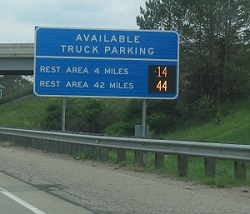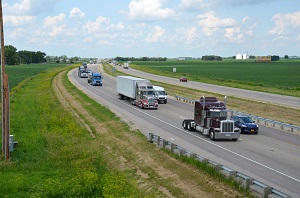WisDOT's Truck Parking Information Management System (TPIMS) is an effort with other Midwestern states to expand access to truck parking technology.
TPIMS uses sensors and cameras to create real-time information about the availability of truck parking. Drivers can monitor for open parking spaces using tools such as dynamic roadside signs. TPIMS enhances safety and efficiency by helping commercial truck drivers plan safety rest periods without having to exit the freeway and waste time and fuel looking for appropriate space.
Wisconsin's TPIMS monitors 483 stalls at 11 Safety Rest Area locations along 250 miles from Dunn County to Rock County on I-39, I-90 and I-94.
- (26 stalls)
Safety Rest Area 9 – Lyndon Station (eastbound), mile marker 74
- (27 stalls)
Safety Rest Area 10 – Mauston (westbound), mile marker 75
- (68 stalls)
Safety Rest Area 11 – Portage (southbound/eastbound), mile marker 113
- (63 stalls) Safety Rest Area 12 – Poynette (northbound/westbound), mile marker 113
- (28 stalls) Safety Rest Area 13 – Lake Mills (eastbound), mile marker 261
- (30 stalls) Safety Rest Area 14 – Johnson Creek (westbound), mile marker 263
- (76 stalls)
Safety Rest Area 17 – Janesville (southbound/eastbound), mile marker 168
- (60 stalls)
Safety Rest Area 22 – Beloit (northbound/westbound), mile marker 187
- (39 stalls)
Safety Rest Area 53 – Millston (eastbound), mile marker 124
- (42 stalls)
Safety Rest Area 54 – Black River Falls (westbound), mile marker 121
- (24 stalls)
Safety Rest Area 62 – Menomonie (westbound), mile marker 43
Safety Rest Area 16 Sparta will be added along I-90 in 2025; Safety Rest Areas 51 Maribel and 52 Denmark will be added along I-43 in 2026; and Safety Rest Area 61 Menomonie eastbound will be added along I-94 in 2027.
TPIMS was made possible by a federal Transportation Investment Generating Economic Recovery (TIGER) grant gained in partnership with other Midwestern states.
Why monitor truck parking?
TPIMS builds additional certainty into the parking process, which is important for commercial drivers. The search for adequate, safe parking can take time and sacrifice earning potential. Lost time spent looking for parking can create losses in productivity.
 Availability of parking can lead drivers to stay on the road looking for a spot, or alternatively choose to park in unauthorized and sometimes dangerous locations such as abandoned parking lots or roadside shoulders. Unauthorized locations raise additional concerns regarding driver safety, roadside safety and deterioration of infrastructure.
Availability of parking can lead drivers to stay on the road looking for a spot, or alternatively choose to park in unauthorized and sometimes dangerous locations such as abandoned parking lots or roadside shoulders. Unauthorized locations raise additional concerns regarding driver safety, roadside safety and deterioration of infrastructure.
TPIMS is another step WisDOT is taking to be freight-friendly in order to enhance economic development. Each year, an estimated 341 million tons of freight valued at $445 billion is moved by truck on Wisconsin roads.
The system also is a step to enhance highway safety. In Wisconsin, commercial motor vehicle drivers being "asleep or fatigued" has been a contributing factor in 386 traffic crashes from 2017 to 2023. These crashes resulted in 5 fatalities, 167 injuries and another 214 that caused property damage.
Using the technology
- All truck parking remains first-come, first-serve. The system simply creates a real-time monitor to display availability.
- Electronic message boards located along the highways will give commercial drivers real-time tallies of available spaces at upcoming rest areas.
- Additional truck parking is available at Wisconsin's
Safety Rest Areas and
Safety and Weight Enforcement Facilities.
Wisconsin’s truck parking technology is part of a wider effort throughout the Midwest. Visit
trucksparkhere.com to learn more.